Massage therapists have a few tricks for using specific pressure techniques without straining their thumbs. Whether light, firm or deep, these handy tips provide support for precious thumb during massage strokes.
These body mechanics require split legs, from 4 inches to shoulder width apart, one behind the other and slightly flexed at the knees and hips. Movement forward springs from the back leg. The visual cue is to imagine your foot pushing the floor away. As you push forward, the hands effleurage the client’s back. When this “fencing lunge” stops, the forward stroke stops. Return strokes should be glides rather than more forceful strokes to avoid activating the lats and rotators, which can lead to shoulder and neck pain.
With these mechanics the length of these strokes depends on the length of the therapist’s arms. Shorter-arm therapists tend to have smaller zones, for instance half the back rather than full length. Taller therapists can cover more territory but are at risk for using their neck and thoracic muscles if they do not take care to split and flex legs.
Here are some photos of thumb-saving stances that allow therapists to work as deeply or lightly as they like. The first is the main thumb saver: Pressing the straight thumb into the flexed index finger and using the other fingers for support. The fingers are flexed so the wrist must be slightly flexed or straight to avoid carpal injury. This allows for stripping along muscle fibers or for transverse friction without risk to the thumb. It also feels better to the client.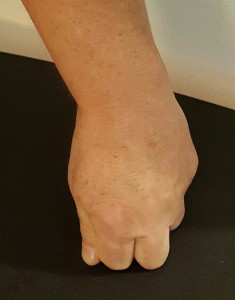
The second photo demonstrates the thumbs pressed against each other, but this time the fingers are spread so the massage therapist can knead with the second phalanges of the fingers. This kneading feels more broad and intense top the client than flat finger kneads. Think of it as a step between finger and forearm kneading.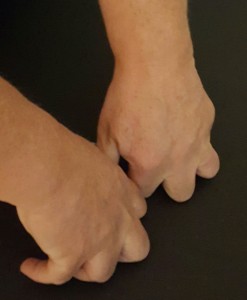
The third photo shows some more thumb stabilization to avoid hyper extension and strain. This time both hands support both thumbs providing a wide and very stable effleurage. 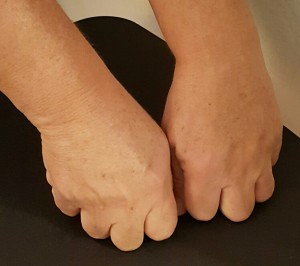
These thumb tips have kept myself and colleagues out of danger while pursuing long careers in healing. One of my clients calls these strokes the teddy bear paws. Thumbs up!
Tag Archives: injury
Taking Chances with Your Massage Muse
Massage therapists are like musicians, athletes and dancers. We train, we practice, and yes, we ache.
Those of us who are in it for real are often playing despite pain. Therapists should be doing all kinds of things to stay in the game, from stretching icing and exercising. But like our musician and dancer friends we are often too busy doing lots of massages and working on our careers to do these things regularly.
Lately folks have wondered about the longevity of a massage therapist’s career based on body mechanics. The stats are kind of miserable: Some newbies are out in three months. The average career is five years. The longer-lasting folks seem invincible but are not really.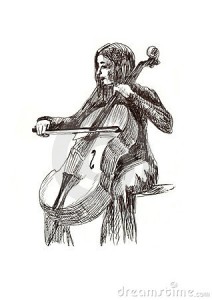
My long-timer buddies look fine but have complaints of tendonitis and numb appendages. In my observation, people who work out or do a cardio activity such as cycling seem to wear well. I will think that and then I see a friend out for six months after an accident on the bike.
I suspect there is no magic formula to surviving and thriving in a massage career, but I also suspect that some people leave their starting gates with their feet tied. Hyper-mobile thumbs, hips, shoulders don’t do that well in time. Too stiff people seem to get by but have a lot of osteoarthritis. A long-time therapist friend (25 years) says it all comes down to whether she can play racquetball twice a week.
Well, we all have our goals/expectations.
The older and wiser therapist, has, hopefully learned. My exercise ball is in my living room; another is at the office. My racquetball-crazed friend has her Pilates reformer in her living room. Another has her own cold laser on the nightstand by the bed. How many ice packs can fit in a side-by-side fridge?
We all know the best prevention of all is massage, of course, and when therapists get a massage once a week they seem to do well. How many of us do it? How many of us pay for it?
My master plan is to continue to enjoy doing massages for a good while longer. That takes dedication to prevention. I feel like the musician who has made it to the symphony. I’d better take care of what I have so I don’t have to retire before I am ready.
What is your strategy? Do you have one? Are you dedicated to prevention, the thing we tell all our clients about endlessly?
Trigger Me Mine
Massage therapists often enjoy showing clients something they can do on their own to relieve a chronic trigger point.
I do it too: “Here, try an old tennis ball and lean up against the wall. Just a little pressure, not your whole weight. Keep gentle pressure on the point for 10 to 15 seconds and then gradually lift.”
Most massage clients are surprised by what they can do one their own. But I am mindful of human nature. Like most therapists, I emphasize caution. “Avoid the urge to push too hard. You will be tempted. But too much pressure for too long can make the point come back much worse later. Always do this easy.”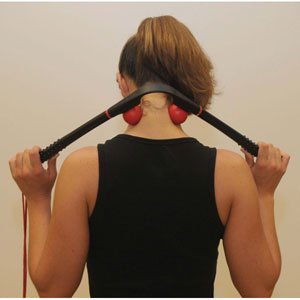
But humanity has its nature. And unfortunately, the numerous videos and self-treatment trigger point therapy books can be the road to perdition.
In the last two years I have had two clients pop in with Olympian trigger points that don’t respond to usual treatment. These trigger points want to stay and drive the clients crazy. What do these two clients have in common? They learned from a book or video how to do their own trigger points.
I had the advantage of learning trigger point therapy in school. The instructors and the books all cautioned students not to go crazy doing trigger points. One by one, every student in my class learned the hard way why trigger point therapy rules are good to follow. I found an especially precious trigger point in my temporalis. I worked it like crazy. Sure that when I erased it I would get relief. Within a few days, I had blinding migraines.
Clients don’t have that experience to help them believe in under-treating trigger points. I am so much more cautious about giving out old tennis balls now.
So what do you do with runaway trigger points? With these clients I tried a few different tactics. The first responded to active release techniques, but the monolith trigger point tended to return after a week or two. The second came around with dedicated, repetitious Swedish massage. I had to get the relaxation system back up and running in the nervous system. Funny, huh?
Plumb Out of Thumb
Body mechanics are important to massage therapists because they can make or break our careers We only have two forearms, two hands and ten fingers So why do many of us take such enormous risks with our thumbs?
When you go to classes for massage, you will hear some jaded tales. “I did this one thing and it took a year to heal.” “I knew it was trouble as soon as I did it.” Or the haughty brag: “I abuse my thumbs all the time and they are fine.” Well, just wait.
Thumb injuries are perhaps worse than the tennis elbow or carpal symptoms many massage therapists can develop because they are a long time healing, prone to immediate re-injury, and crippling for other life activities.
Most of us know better, but sometimes we do something without thinking. (Really?) The thumb can become a lightning rod when injured, because many of our techniques require the use of both pressure and specificity. The thumb provides both, but used recklessly can end your career.
I’m going to list the ‘rules of thumb’ for massage therapists.
Never hike out alone: When the thumb is split away from the fingers, you may think it gives a better sensation of pressure. Actually it does not. The client will feel a marked difference between thumb and finger pressure, not in a good way, while you are risking hyper-extension. At worst, your client will feel as if the thumb is digging while the fingers glide. Your hand, meanwhile, will be all set to resolve that hyper-extension by crimping into flexion while you sleep, compressing the radial nerve and carpal tunnel.
Stick Together: With nearly all massage moves, the thumb should be pressed against and supported by the fingers. This spreads the pressure evenly and results in a glide or effleurage that feels better to the client and to your hand. The entire palm, not just fingers, is used for these moves. What about wringing? Try it with the thumb stuck to the fingers. It will feel better to you and the client.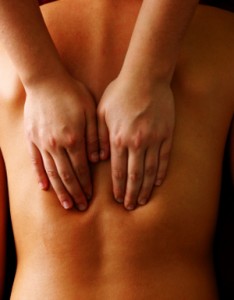
Thanar, not thumb: When the angle of a stroke tempts you to swing out the thumb, try using the thenar surface, the underside of the thumb, with the upper thumb pressed to the index finger. An example is in trying to shift the lateral quadriceps away from the ilio-tibial band. Using the thenar surface preserves the strength of the stroke without endangering the digit.
Two thumbs and eight fingers are better than one thumb: Depending on the shape and length of your phalanges, you can press two thumbs together to do a specific power glide – as long as the fingers are flexed at the second joint so you are using the thumbs with support on both sides. The second joint is the one just up from the knuckle.
No Lollygagging: Never drag the thumb behind a stroke. This is total thumb suicide.
Lucky for us all, good mechanics also feel much better to the client. If it hurts the client or will hurt you, why do it?
Massage Heals Whiplash
Massage at the Top of the Spine
People who have suffered whiplash are a good number of the clients in massage therapists’ practices. They seek relief from neck and shoulder pain, tension headaches, migraines and fatigue.
Massage does wonders for sore muscles of the neck and shoulder even years after a whiplash. It opens fused muscles, improves circulation of blood and lymph, and helps muscles re-learn movement.
Usually people with whiplash have been around to many different doctors and therapists. Often they have gone as far as they can with them and have decided to try massage to reduce symptoms.
And here is where the massage therapist can shine. Depending on whether the whiplash was from the rear, front, sides or diagonal directions, massage can open up clogs of adhesed muscles and return their natural movement.
Most have thick fibrous bands starting at the occipital ridge and ligamentum nuchae, and simple Swedish strokes – softly drawing away from the occiput and gliding back – can draw down the congestion.
Light to medium trigger point work on taut bands of the trapezius, splenii, scm’s and scalenes will further restore motion.
What I find, however, is that many clients tell me massage therapists shy away from their 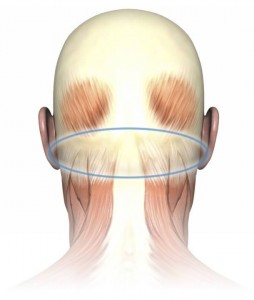 whiplash zones, even though this relatively simple work will bring much relief.
whiplash zones, even though this relatively simple work will bring much relief.
The whiplash survivor is not a china doll, but someone who needs the relief of massage.
Sometimes we are used to massaging the thick muscles of the shoulder area but clients start to cringe when we move up to the neck. It is a natural reflex to dig in to hardened tissue of the neck in order to loosen it. Actually, the opposite works much better. When I check the neck I soften my hands and do more soft molding strokes. I want the defenses to drop, not increase. When hands are soft, the tissue responds by allowing you to massage more deeply, but with gentleness.
Another common reflex is starting a stroke lightly and adding pressure as it proceeds. In effect, it is a grinding motion and a very unpleasant sensation to the client.
Instead, use the same medium pressure throughout the stroke. Go back and start the stroke again with slightly more pressure, repeating and adding slightly to the pressure with each glide, taking care not to depress the vertebrae. At the end of four to six strokes, the tissue will have been opened and drained. Success!
Drawing away from the congestion and doing light pressure techniques on the neck and upper shoulders will bring a great deal of relief without having to get into more complex techniques best left to intensive workshops. There is no reason to be afraid of making these areas worse. Your hands can’t go from 40 miles per hour to zero in one second!
A few who have had severe whiplash – and survived – they are the tough clients. Their symptoms are more serious – vertigo, sleep disruptions, fascia that forms nooses and restrictive loops over the years of compensating for severe imbalance.
I like to think I have great massage skills for all these folks, but I am cautious. Have neurologists or osteopaths with experience in these dysfunctions evaluated their injuries? Are they stuck or hyper-mobile? Have they had an increase in symptoms from additional injuries?
Massage Hygiene and the Return Visit
People who give massages hopefully like receiving massages. I know I do. When my therapist friends are out of town or otherwise engaged, I have a few places I will slip into to try their hands.
I found one therapist purely by chance who really knows how to do meridian and nerve-based massages, something my low back appreciates greatly. So I was surprised when I got into the shower one day a few hours after my massage and found large, red welts on my back, suggesting that I had teenage cystic acne.
In the mirror I saw big, red and itchy bumps all over my back, especially on the lines of the sideline meridians. I had either had a reaction to the massage oil or somehow some sort of bacteria had been introduced into the skin during the massage.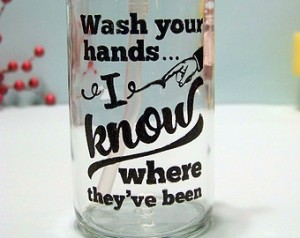
I thought, probably like many clients, that I should simply not visit this therapist again. Something had been dirty, the oil, the bottle, the hands, something. I had showered just before the massage, so I did not think it was my skin. Oh well.
Then perhaps, like some clients, I though about the affection I had developed for this particular therapist. I liked her style and her results. I decided to see her again and tell her about my reaction.
Once we were alone in the massage room, I explained that I had some sort of reaction to the massage and had been nursing the bumps with arnica and witch hazel. I showed her the pattern on my back. She looked stunned.
“But I always wash my hands, and I make sure the linens are clean and fresh.” she said. I pointed at the oil bottle. “Do you wash it? Wipe it? Does anyone else use it?”
Hmm. That was possible, she said.
As massage therapists we see a lot of people and often use the same bottles and oils on each client. Can someone have sensitive skin? Sure. But what if it was the oil layer on the outside of the bottle? What if the oil itself was contaminated with bacteria?
No sure answers there. But here are the basics of keeping clean between massages and during successive massages in a busy practice or clinic.
- Always wash hands after and before a session. Washing hands at the end of a session is a half-measure. You will handle materials, perhaps dirty linens, doorknobs, credit card machines, etc. before your next massage. Wash hands again before you start.
- Wash the exterior of your oil bottle as well, especially if someone else is using your room and supplies on your days off. Slick bottles can transfer bacteria to all of your clients that day and beyond. I wash oil bottle every day and use anti-bacterial wet wipes to clean bottles between clients.
- Never stack linens for more than one client. Some therapists think they have found a great way to avoid scrambling for linens by putting five or six settings on the table. Well, no certain infections, such as scabies, can be passed from one sheet to another. You don’t want to be explaining your timesaving system to an inspector from the health department.
- Hand washing is done with warm to hot water and soap and requires rubbing both hands together for at least 15 seconds. Rinsing, one-handed washings, or other half-measures don’t count. Over the years I have learned to follow-up my hand washing with a cold-water rinse. Good for my poor paws.
- When using a jar or tub of massage cream, use a clean or disposable spatula to scoop from the jar. If you stick your fingers in the jar, you are cross-contaminating any bacteria to your whole client book for that day and as long as you use that jar. Cover the jar in between scoops. Better yet, use oil with a pump or flip-top.
- Use cleaning cloths with hot water and a cleanser or anti-bacterial wet wipes on common surfaces such as towel warmers, crock pots, essential oil bottles, anything in the room that might be touched by oily hands. If you only clean when it is slow, or you rely on a cleaning crew for these details, you may be spreading bacteria and other germs.
- Some massages start with a foot massage, either because of the client’s symptoms, wishes or the therapist’s training. Tell your client as you finish their feet you are going to wash your hands and will be back in a moment. Some people have fungal infections, bacteria, etc., or go barefoot, and your foot massage can spread skin infections to other areas of the body.
Better safe than sorry. By the way, I decided to stick with my therapist, largely because she was concerned and eager to learn how to prevent more skin reactions. Just like a client, I appreciated her attitude and its promise for future reaction-free massages. Cleanliness fills your book.
Massage to Measures
Massage therapists like to think we help people deal with stress, injuries and fatigue. But how do we know we help?
Massage is, after all one-on-one. We are stars or idiots one hour at a time, and we often don’t take much credit for our clients’ successes or failures. Is a massage therapist a facilitator or a game-changer? Do we really know?
I’m reminded of the times I thought I had no clue what I was doing, only to have the client hop off the table and give me a compliment and a big tip.
But I also remember that once on vacation – after one particularly hideous massage from someone who thought they were fantastic – that I said thank you and left a tip anyway. I made a mental note of the therapist’s name in case I ever happened to go to this resort again so I could get someone else.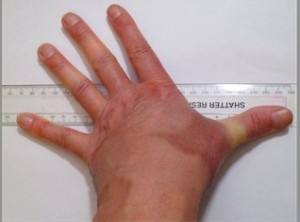
How we measure ourselves and our effectiveness in massage therapy is something of an emerging issue. In a practice that is more art than science, can we really measure ourselves?
People have often received treatments for medical conditions that have no proof or promise – but the treatments are tried in the belief that they may relieve suffering or repair the underlying condition. That is the art of medicine.
Can we also preserve the art of massage while some therapists attempt to move into the medical – and the reimbursed – field?
A recent post by long-time and very respected massage instructor Noel Norwick of Los Angeles asked the question on Facebook.
His question on medicalmassage@groups.facebook.com group referred to a study. It found that soothing talk – reassurance – worked just as well as physical therapy treatment after whiplash. Here’s the link: http://www.bodyinmind.org/treating-whiplash
It appears to say that treatment versus soothing talk have the same results. My comment was that it might say much about the quality or delivery of treatment instead of its effectiveness in the right hands.
Would that be the case if reassuring talk were compared to massage? I think not. Hope not. But let us ask this question another way – if we could offer nothing hands-on, would we offer reassuring speech? Isn’t that sometimes the de facto treatment for stress disorders – even though many of us would propose that massage would be much better?
Smart Companions
 Numb fingertips, cramp-y necks and para-spinals that feel like abandoned rock quarries. We massage therapists treat the injuries that computer technology can produce.
Numb fingertips, cramp-y necks and para-spinals that feel like abandoned rock quarries. We massage therapists treat the injuries that computer technology can produce.
My smart phone just updated itself (can it reproduce?) revealing the phrase “Lifetime Companion” on the home screen. Really? This whole phone thing has gotten out of hand.
People are ruining their eyesight, developing dowager humps and filling up my schedule book from peering at tiny screens. Weren’t these things supposed to help us?
Device injuries have delightful names such as Pac Man Pinky, Smart Phone Presbyopia, and Blackberry Thumb. Let’s hear it for the names. But when are we going to get devices that do not turn us into garden gnomes?
I have been waiting…tap…tap…tap. Captain Kirk just had to ask the computer to do stuff, he dictated his log, and sometimes he would twist a little button on his communicator. The only repetitive motion he suffered was trying to do that funny split-finger salute when Spock introduced him to the fam.
The techies have been awaiting the Apple I Watch, a device that looks like we will all be hunching over something even smaller in the coming months.
We massage therapists can hear a “Ca-Ching!” in our futures. The devices are not getting better. They are getting us more work than we can handle. So much for getting to that seminar in Costa Rica this year….
Thumb Scrum
Massage therapists may think they are immune to injury, even though many of us came to do massage after recovering from injury. We’re helping people, after all, so that should be a win-win. We win, the clients win, all is right.
Oh, and then that little thumb screams tingle-tingle in the middle of the night.
The problem with bad thumbing is that it doesn’t tell you that it is hurting while you are doing the hurting thing. It tells you much later in the day, usually just before your deepest sleep cycle, by waking you up to a tingle party.
Oh, and it can take months of babying to get better. I know. I did it recently, as in earlier this year. Many soaks, rubs, deep cross-friction and MSM lotions later, I can say my thumb has returned as fit as ever. Of course, I know how not to hurt my thumb, I just suffered some sort of temporary delusional amnesia associated with getting that last knot out from under the cranial vault.
For the record, let’s go over thumb health. The thumb is a wimp, unable to go outside without his brothers and sisters. Thus the thumb is always stuck to its neighboring fingers when applying any pressure or other massage stroke.
Do not drag the thumb behind its family, keep it close – as in stuck – to its protectors.
Do not lead with the thumb unless it is stuck completely to the other thumb – that is both hands together at the thumb creating one seamless stroke.
If your thumb is able to bend backwards at the first joint, you will get away with disobeying all these thumb rules, but then the day will come when the thumb quits altogether. This is the curse of the hyper-mobile thumb.
As someone who occasionally forgets to practice safe thumb, I admit to being less than perfect while on trigger point hunts. But I know my thumb will remind me later of what I forgot earlier in the day. Zap!
Offering Reassurance and Hope to Your Clients
When will this get better? When will my pain be gone? When can I do what I want to do – when I want to?
Tough questions for us massage therapists to handle. Truth, we don’t usually know. Massage does marvelous things for the mind, body and soul – but what it does is often entirely up to the person receiving the massage – and the intent and skill of the person giving the massage.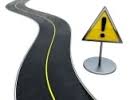
The timeline? That may be set by many other things – perhaps even a higher authority.
When clients drop these questions on me I look them right in the eye and tell them all I can do is try to help them feel better. As pain drops, function returns. One can’t predict the time involved in healing.
It’s not a very satisfactory answer for some clients impatient to going back to doing the exact thing that brought them in feeling wounded. With as soft a tread as possible, as we develop a therapeutic relationship, I have a few ways to explain further. These come in handy with sticky troubles such as fibromyalgia or other conditions that vary day by day.
Answer # 1: You will turn the corner, but you may not realize it. Often you realize it afterward. You will discover that some pain or restriction has been gone for a while.
The body really heals itself in its own time. All we can do is try to make it easier to get there.
Is that fair to clients? I think so. I have rarely ever seen someone making no progress from massage. But I have often observed one factor in common with the impatient client: A chronic problem has often been ignored for so long it takes time to create an awareness of how to heal and avoid re-injury.
